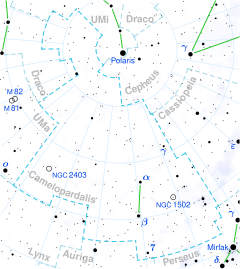1 Camelopardalis (1 Cam) is a double star system in the constellation Camelopardalis. Its combined apparent magnitude is 5.56 and it is approximately 800 parsecs (2,600 ly) away.
The 1 Camelopardalis system is part of the Camelopardalis OB1 stellar association, which is 820 pc away.[12] 1 Camelopardalis A is a hot massive star which has evolved away from the main sequence to become a giant. 1 Camelopardalis B is 10" away and is probably an early B class subgiant.
There is an 11th magnitude star 150" away.[13] It has been considered to be a member of a triple system,[12] but Gaia observations show it to be an unrelated background object.[14]

1 Camelopardalis A is a variable star with a small amplitude. It has a likely period of 0.22132 days and is thought to be a β Cephei variable or slowly pulsating B-type star.[16] Hipparcos photometry shows an amplitude of 0.035 magnitudes.[17] It has a rotational velocity of 275 km/s, one of the highest known.[10]
References
edit- ^ a b c d e Brown, A. G. A.; et al. (Gaia collaboration) (2021). "Gaia Early Data Release 3: Summary of the contents and survey properties". Astronomy & Astrophysics. 649: A1. arXiv:2012.01533. Bibcode:2021A&A...649A...1G. doi:10.1051/0004-6361/202039657. S2CID 227254300. (Erratum: doi:10.1051/0004-6361/202039657e). Gaia EDR3 record for this source at VizieR.
- ^ a b Høg, E.; Fabricius, C.; Makarov, V. V.; Urban, S.; Corbin, T.; Wycoff, G.; Bastian, U.; Schwekendiek, P.; Wicenec, A. (2000). "The Tycho-2 catalogue of the 2.5 million brightest stars". Astronomy and Astrophysics. 355: L27. Bibcode:2000A&A...355L..27H.
- ^ a b c d e Brown, A. G. A.; et al. (Gaia collaboration) (2021). "Gaia Early Data Release 3: Summary of the contents and survey properties". Astronomy & Astrophysics. 649: A1. arXiv:2012.01533. Bibcode:2021A&A...649A...1G. doi:10.1051/0004-6361/202039657. S2CID 227254300. (Erratum: doi:10.1051/0004-6361/202039657e). Gaia EDR3 record for this source at VizieR.
- ^ Sota, A; Apellániz, J. Maíz; Morrell, N. I; Barbá, R. H; Walborn, N. R; Gamen, R. C; Arias, J. I; Alfaro, E. J (2014). "The Galactic O-Star Spectroscopic Survey (GOSSS). II. Bright Southern Stars". The Astrophysical Journal Supplement Series. 211 (1): 10. arXiv:1312.6222. Bibcode:2014ApJS..211...10S. doi:10.1088/0067-0049/211/1/10. S2CID 118847528.
- ^ a b c d Hoffleit, D.; Warren, W. H. (1995). "VizieR Online Data Catalog: Bright Star Catalogue, 5th Revised Ed. (Hoffleit+, 1991)". VizieR On-line Data Catalog: V/50. Originally Published in: 1964BS....C......0H. 5050. Bibcode:1995yCat.5050....0H.
- ^ Samus, N. N.; Durlevich, O. V.; et al. (2009). "VizieR Online Data Catalog: General Catalogue of Variable Stars (Samus+ 2007-2013)". VizieR On-line Data Catalog: B/GCVS. Originally Published in: 2009yCat....102025S. 1. Bibcode:2009yCat....102025S.
- ^ Lutz, T. E; Lutz, J. H (1977). "Spectral classification and UBV photometry of bright visual double stars". The Astronomical Journal. 82: 431. Bibcode:1977AJ.....82..431L. doi:10.1086/112066.
- ^ a b Westin, T. N. G. (1985). "The local system of early type stars - Spatial extent and kinematics". Astronomy and Astrophysics Supplement Series. 60: 99. Bibcode:1985A&AS...60...99W.
- ^ a b c Holgado, G.; Simón-Díaz, S.; Haemmerlé, L.; Lennon, D. J.; Barbá, R. H.; Cerviño, M.; Castro, N.; Herrero, A.; Meynet, G.; Arias, J. I. (2020). "The IACOB project. VI. On the elusive detection of massive O-type stars close to the ZAMS". Astronomy and Astrophysics. 638: A157. arXiv:2005.05446. Bibcode:2020A&A...638A.157H. doi:10.1051/0004-6361/202037699. S2CID 218596165.
- ^ a b Cazorla, Constantin; et al. (2017). "Chemical abundances of fast-rotating massive stars. I. Description of the methods and individual results". Astronomy and Astrophysics. 603: A56. arXiv:1703.05592. Bibcode:2017A&A...603A..56C. doi:10.1051/0004-6361/201629841. S2CID 59499133.
- ^ a b c Simón-Díaz, S.; Godart, M.; Castro, N.; Herrero, A.; Aerts, C.; Puls, J.; Telting, J.; Grassitelli, L. (2017). "The IACOB project . III. New observational clues to understand macroturbulent broadening in massive O- and B-type stars". Astronomy and Astrophysics. 597: A22. arXiv:1608.05508. Bibcode:2017A&A...597A..22S. doi:10.1051/0004-6361/201628541. S2CID 3478126.
- ^ a b Straižys, V.; Laugalys, V. (2007). "Young Stars in the Camelopardalis Dust and Molecular Clouds. I. The Cam OB1 Association". Baltic Astronomy. 16: 167–182. arXiv:0803.2461. Bibcode:2007BaltA..16..167S.
- ^ Mason, B. D.; et al. (2014). "The Washington Visual Double Star Catalog". The Astronomical Journal. 122 (6): 3466–3471. Bibcode:2001AJ....122.3466M. doi:10.1086/323920.
- ^ Brown, A. G. A.; et al. (Gaia collaboration) (2021). "Gaia Early Data Release 3: Summary of the contents and survey properties". Astronomy & Astrophysics. 649: A1. arXiv:2012.01533. Bibcode:2021A&A...649A...1G. doi:10.1051/0004-6361/202039657. S2CID 227254300. (Erratum: doi:10.1051/0004-6361/202039657e). Gaia EDR3 record for this source at VizieR.
- ^ "MAST: Barbara A. Mikulski Archive for Space Telescopes". Space Telescope Science Institute. Retrieved 8 December 2021.
- ^ Jerzykiewicz, M. (1993). "Three known and twenty-two new variable stars of early spectral type". Astronomy and Astrophysics Supplement Series. 97: 421. Bibcode:1993A&AS...97..421J.
- ^ Lefèvre, L; Marchenko, S. V; Moffat, A. F. J; Acker, A (2009). "A systematic study of variability among OB-stars based on HIPPARCOS photometry" (PDF). Astronomy & Astrophysics. 507 (2): 1141. Bibcode:2009A&A...507.1141L. doi:10.1051/0004-6361/200912304.
